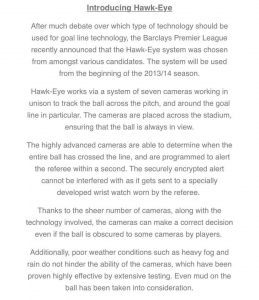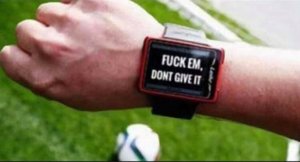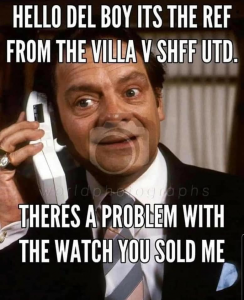So i'm as pissed off about the result as the next Blade, but amidst allegations of corruption etc. I think it's probably worth there being some clarity on a few things - at least as much clarity as I have from my own understanding of the rules and technology. I should clarify I'm not a camera engineer, nor any kind of authority on Hawkeye, but that I think i've got a pretty good understanding of how the tech likely works based on my general knowledge of technology, physics, computers etc.:
1) Hawkeye cameras - the cameras themselves don't "remove" the players from the image. They aren't clever enough to disregard light rays reflecting off a (moving) player but to keep the ones from the posts, ball, etc. I suspect (strongly) the Hawkeye system uses high-speed, high-resolution cameras, the feed from all of which is combined using triangulation to locate the ball, and stereoscopy / photogrammetry techniques to remove the elements not required. The cameras themselves aren't magic - it's the controlling software doing the post-processing.
2) Occluded views - I can accept that there is at least one (more likely several) combinations of position of moving objects (ball, players, referee(s)) that mean that the line of sight from each of the 7 fixed cameras to the ball is blocked at a particular instant. Hawkeye say they only need 2 cameras to plot the ball position (see 1) above), and i guess as the cameras are in the stands then it doesn't necessarily need to be a player near the ball or in the goal mouth that is blocking the view? If this is the case, then I'm astonished that it has taken over 9000 matches for this particular and specific combination of occlusion to occur. I feel, with the benefit of reflection, that this is likely to be an oversight of the system development - football isn't like cricket, with less moving parts and moving people in a small area. Someone has probably said "noone will ever block more than 5 of the 7 cameras - she'll be right!". It was shortsighted, and why they don't also have an overhead camera on a post behind the goal looking straight down to feed into the Hawkeye system i don't know.
3) Other cameras - I suspect Hawkeye and Sky etc. aren't linked at all, and even if they were, the cameras used for broadcast pictures by Sky et al are unlikely to be of sufficient quality, frame-rate and resolution to be able to feed accurate data into the Hawkeye "model" of the ball position. The Hawkeye cameras will be in fixed positions, and their locations and various key dimensions no doubt programmed into the software to allow the calculations to take place, so the Hawkeye programme at each ground will be bespoke. the Sky cameras aren't likely to be in EXACTLY the same location every time - they might move an inch here or there, and that would be enough to mess up the calculations the computers will be doing to track the position of the ball.
4) VAR - the GDS / VAR implementation adopted by the FA and EPL differs from the rugby implementation in as much that rugby relies on the ref and asks VAR if there is a reason the refs decision shouldn't stand, whereas football asks more black-and-white, yes-or-no questions without recourse to the referees own opinion. In this case, My understanding is that VAR only reviews goal decisions or penalties etc. and the list of thinks VAR can intervene for is limited. If the GDS had gone off, VAR would have looked to confirm the ball was over the line. Under the EPL implementation, I don't think referees generally have recourse to "referring" the decision to VAR - again differing from the rugby system. Ditto the pitchside monitors etc.
5) Michael Oliver - his hands were, as I understand it, a bit tied by the above. The only recourse would have been if VAR thought there was a potential penalty, at which point the review would have taken place. Again, VAR doesn't seem to check goalmouth scrambles unless the goal goes in, or there is a potential penalty. If that review had happened, I don't know if the response would have been "Mike - no penno, but you do know the ball went across the line, right? Did the watch not go off for it?" or not. I don't lay any particular blame at his feet if i'm honest. Even if the liner had been in the right place and flagged for the ball going in, would he have overruled the GDS? Or would you just assume it had looked like it was over but the GDS must have said it wasn't quite over - and again, had that happened i don't think the protocols don't allow Oliver to "refer" to VAR.
Most of these issues can be solved, in my eye, by the simple recourse of the VAR being required to look at every incident in some way or another; by letting referees ask for VAR input in the same way rugby do (i.e. "I think that might have been a goal, and the players seem to think it was in despite the GDS not triggering. Can you confirm if the ball crossed the line, or if there is another reason I can't award the goal?"); by implementing pitchside monitors in the EPL as they do in the UCL and encouraging referees to use them; and finally by implementing some sort of "challenge" system as there is in tennis.



